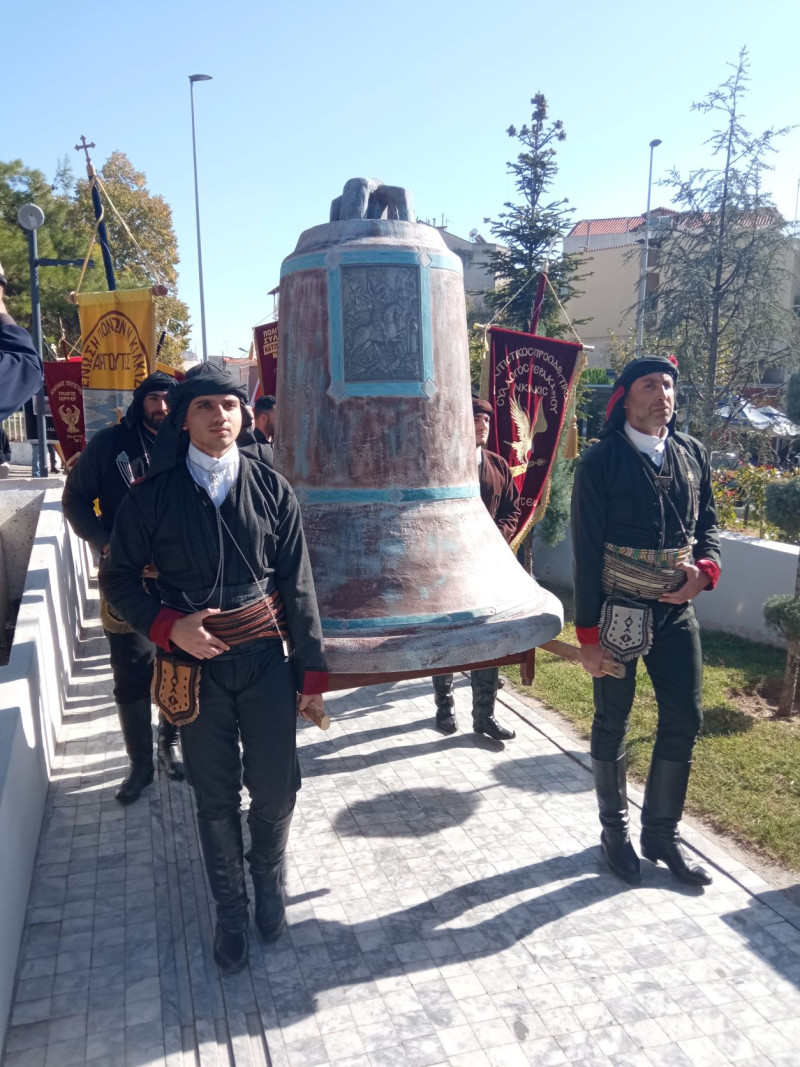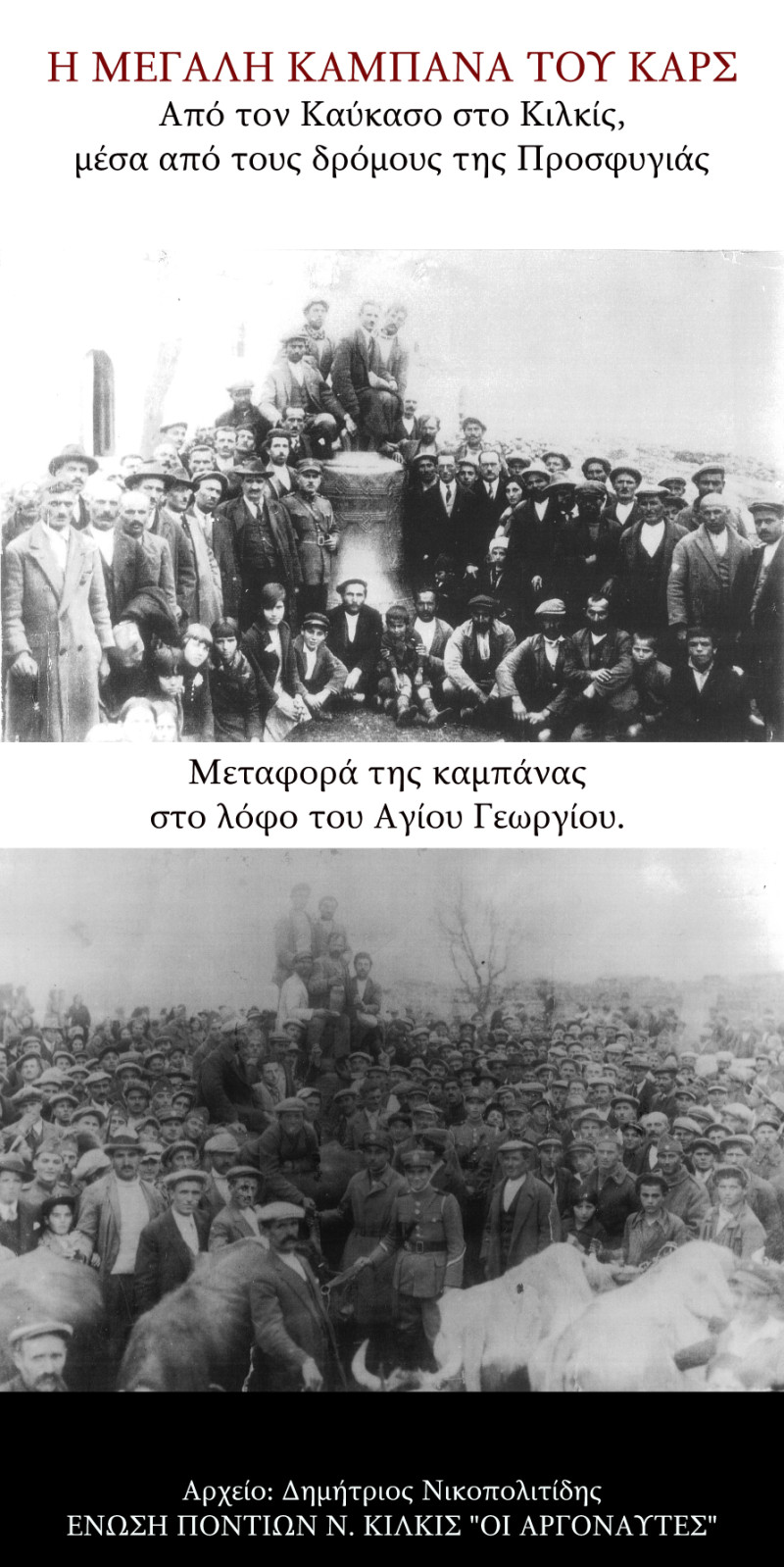This bell was a gift from Tsar Nicholas II of Russia, the last of the Romanov dynasty, to the Church of the Transfiguration of the Savior
Anastasios Amanatidis was only 15 years old when he climbed the bell tower of the Metropolis of Kilkis, hung from the tongue of the huge historic bell of Kars, gathered his feet and became invisible inside its dome. He still remembers its image, its hazy gray and dark green color and its shape which, he says, did not even resemble the large bells found in the Panteleimon Monastery on Mount Athos. “Those were more like a cone shape and their neck at the top was narrower. By contrast, the Kars bell tower was majestic. Her girth was much larger and the whole thing resembled the shape that fur dresses once had. Its height must have been around one and a half meters, its materials copper and brass and its weight four tons. On it was the image of the Virgin Mary with Christ, Saint George and the Transfiguration of Christ with the six wings, while on its border, at the bottom, there were two rows of carved phrases in the Cyrillic script. I don’t know what he wrote…” Mr. Amanatidis, a doctor and former mayor of Kilkis, reports to APE – MEB.
Gift of Tsar Nicholas II of Russia
“…This bell was a gift from Tsar Nicholas II of Russia, the last of the Romanov dynasty, to the Church of the Transfiguration of the Savior, a marble temple that the Greek Pontic Caucasians of Kars managed to build in the first twenty years that they were found there” he narrates, unfolding the history of the bell. “The Russian soldiers used to worship in this church, which is why it is possible that the Tsar was moved by visiting them and decided to donate the bell. In Russia, after all, there were workshops and foundries of many such codons, as the Pontians called bells at the time” he adds meaningfully. This bell, together with ten other small subsidiaries donated by the Tsar, were rung together in eulogies and celebrations, as the temple was the pride of the Greek parish.
According to Mr. Amanatidis, when the October Revolution took place in 1917 and Russia withdrew from World War I, the Russians left the area and the Pontians were exposed to the Turks. Turkey later withdrew as it lost World War I to Germany and the region was annexed by Bolshevik Russia. In the end the area came back to Turkey. Faced with the emerging situation, the Greek Pontic Caucasians began to leave Kars in a resettlement that was completed at the beginning of 1921 and, as he says, has nothing to do with the Asia Minor disaster, since it happened two or three years before it. “With pleas to the prime minister, Venizelos, before the 1920 elections, the Greek Caucasians asked Greece to send ships to take them. They then gathered in Vatum waiting for the ships while a group of service agents helped the people to come to Greece” he notes.
Severe hardship and many victims of typhus
Throughout this time, the hardships faced by these people were great as they began to move in squalid conditions and under an epidemic of typhus transmitted by lice, due to overcrowding, overcrowding and lack of cleanliness. “There were dozens of deaths every day. Many died on the ships and were thrown into the sea. Those who had contracted typhus went crazy since the disease brought fever, caused rashes and clouded the mind,” points out Mr. Amanatidis. He also does not fail to talk about those who lost their lives from suffering, difficulties and diseases when they arrived in Kalamaria or other ports in Greece. He speaks of large populations that moved since, as he says, “75,000 were Caucasians and as many from the northern regions of Crimea and Sukhumi. After all, it is estimated that there were even 400,000 Greeks there at that time”.
The sensational journey of the bell
As for the journey, people took with them what they could get. In a panic they decided to take the bell, since their only hope. It was their faith, their religion, their bond with the church. They loaded her with difficulty on the train, as she weighed four tons, and from Kars she was transported to Tbilisi and from there to the port of Vatum. While father Ioannis Kakoulidis and the others who accompanied her waited at the port, her bell ringer fell into the sea and was lost.
After all, when it was loaded onto the ship, some say the ship tipped to one side and they had to shift the load of lumber to balance it. The journey was long and in the end the ship arrived in Thessaloniki. The refugees disembarked in Kalamaria for the disinfection process to follow, where all those traveling by ship passed through at that time when the plague, smallpox and other diseases were literally rampant. The bell, which was very heavy, was unloaded at the port of Thessaloniki and remained there for some time after the priest and all those who accompanied it on its journey breathed their last in Kalamaria.
After 2 – 3 years the Pontian clubs from the Caucasus, looking for money for the students to study, sold the bell for 80,000 drachmas to the Caucasian clubs of Kilkis. From there people with carts drawn by six pairs of oxen and buffaloes managed to get her up the hill of Agios Georgios in Kilkis. “People accompanied the bell with tears in their eyes and in the end it arrived and was set up in the church of Agios Georgios” comments Mr. Amanatidis and emphasizes that from there its piercing sound could be heard even 25 kilometers away, reaching all the refugees villages in the area.
Sometime between the 1940s and 1950s the bell was taken down from Agios Georgios and installed in the Kilkis Metropolis, in a tall stone belfry. Mr. Amanatidis also brings his childhood memories from there.
When the bell rang…
At some point, however, the bell cracked as the metal apparently failed to withstand the changes in weather conditions and its bass sound was no longer the same. “The despot Joakim Smyrniotis said then: “as if my heart broke when I heard the bell on Good Friday ringing hoarsely”. Indeed, I also remember the bell cracked from top to bottom and the sound it made as the crack affected its ringing” notes Anastasios Amanatidis. So it was decided that the bell would end up in the foundry and 7 more bells would be made from the same metal, the… children of the bell of Kars. 5 of them were placed in Kilkis Metropolis and another two in churches of the same Metropolis that did not have bells. And the despot convinced his interlocutors that “it was as if the seven bells were made with the soil that the Pontians brought from their homeland…”.
Rumors of gold
Then began the rumors that began to circulate among the faithful and according to which, in order for the bell to have such a sound, it would have to contain some precious material, perhaps even gold. The despot decided to set up a commission in which notables from Kilkis participated. They went to the foundry in Thessaloniki and found that there was no precious metal in the bell. Joakim Smyrniotis died in 1965, however in recent years objections to the destruction of the bell began to revive.
Representation of the reception of the bell of Kars
A few days ago, on the initiative of the Pontian Union of Kilkis “The Argonauts”, in collaboration with cultural-Pontian associations of Kilkis and under the auspices of the Kilkis Regional Unit, the reception of the Bell of Kars was reenacted, when before decades it was transferred to Kilkis. The protagonist of the reenactment was the bell, not of course the original one but a styrofoam replica of it which, with a solemn march, which started from the Kilkis Municipal Stadium, ended up in the municipal park “Kipos”. Those who accompanied the replica bell on this march saw the photos of the original Kars bell up close in the photographic exhibition with images from the archive of Mr. Dimitrios Nikopolitidis.
Mr. Amanatidis, for his part, recognizes that in those years the priority for the people who went through so many difficulties was survival. “In the poverty and suffering of the refugee, everyone cared about raising their children while the feeling of historicity and the need for its preservation disappeared” he comments. However, he points out meaningfully: “it was a shame that they melted her down. Let it be put in a place, in a museum, just so that the world can see it and let it no longer ring like before, and let it be useless…’.
RES-EMP
Read the News today and get the latest news.
Follow Skai.gr on Google News and be the first to know all the news.
I am Terrance Carlson, author at News Bulletin 247. I mostly cover technology news and I have been working in this field for a long time. I have a lot of experience and I am highly knowledgeable in this area. I am a very reliable source of information and I always make sure to provide accurate news to my readers.












